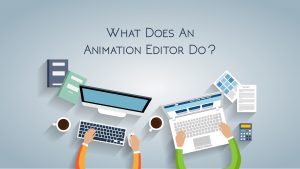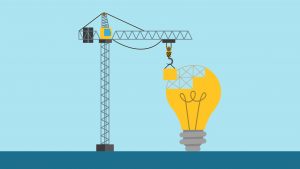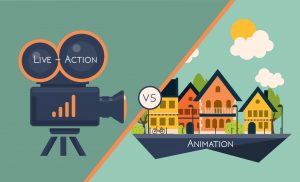30 Jan What Does An Animation Editor Do?
 Have you ever heard of an animation editor? What do you think they do? Is it even necessary to edit animation? It’s a common misconception for people to think that animation doesn’t get edited. However, being an animation editor is the most important job you could have.
Have you ever heard of an animation editor? What do you think they do? Is it even necessary to edit animation? It’s a common misconception for people to think that animation doesn’t get edited. However, being an animation editor is the most important job you could have.
What is an Animation Editor?
You could say an animation editor is an artist, problem solver, team player and business orientated person. To create an animation, hours of editing and reviewing an idea will tell an effective story.
 As an animator, I have experienced editing first hand. It’s a very important job that shouldn’t be taken lightly. You would think animation is planned to a tee beforehand where scenes are written, shots are animated and clips are put together in the order they were written, right? Wrong, the process is more complex than you would think an editor would do.
As an animator, I have experienced editing first hand. It’s a very important job that shouldn’t be taken lightly. You would think animation is planned to a tee beforehand where scenes are written, shots are animated and clips are put together in the order they were written, right? Wrong, the process is more complex than you would think an editor would do.
Main Responsibilities
 As an animation editor, you are involved in every process of planning and production, you may even help with the concept and end up writing or re-writing scenes yourself. Making an animation is a collaborative effort and is usually completed with a team of people. As an editor, you are involved in the Animation process from the beginning all the way to the end.
As an animation editor, you are involved in every process of planning and production, you may even help with the concept and end up writing or re-writing scenes yourself. Making an animation is a collaborative effort and is usually completed with a team of people. As an editor, you are involved in the Animation process from the beginning all the way to the end.
Animation Process
The animation editor is involved in all sections of the Animation Process:
- Idea Generation: The editor sits with the director (editor and director can be the same person in small projects) thinking of a concept for a story and aligns each others’ vision.
- Style and Character Design: The editor helps to decide on the look, feel, mood and style for the animation and characters.
- Script and Storyboard: The editor sits down with the director to get all the details concerning dialogue and camera angles.
- Animatic: A static visual display of each scene is created with the placement of desired sound and music. This is essentially a rough draft before animating begins to check the flow of the story and possible changes of the order of the visuals or sound.
- Creating Content: Content is created to use in the animation.
- Animating: Editing and reordering the footage is essential in telling the story in the most direct way possible, following the director’s vision. Making alterations such as adding or subtracting time and selecting specific footage will allow for a good creative output.
- Pace & Timing: The editor checks that the animations have good timing and that the sound and music conveys the desired mood and pace.
- Intercutting: Changing between compositions and alternating footage to create the desired effect.
- Syncronizing: Ensures the sound effects play in time to the visuals. Music is reviewed to see if it fits the animation well and recorded voices are synchronised to the mouth movements of the characters.
 The editing process starts before production even takes place and can be up to 2 years to complete, depending on the size of the production. The editing is the story building process where ideas change and evolve continuously. No matter how much you plan for animation, it’s a guarantee that you will end up with something radically different to your planned storyboard and script. The editor can land up being part of the film almost as long as the director.
The editing process starts before production even takes place and can be up to 2 years to complete, depending on the size of the production. The editing is the story building process where ideas change and evolve continuously. No matter how much you plan for animation, it’s a guarantee that you will end up with something radically different to your planned storyboard and script. The editor can land up being part of the film almost as long as the director.
Even though the animation is planned out from the get-go, the first attempt doesn’t always work and revisions are made to refine the animation. This can take around 3-4 attempts before getting an animation that flows properly conveying the director’s views.As you can see the animation editor is involved in all sections of production as planning and editing are needed every step of the way to create an animation that is breathtaking.
Live-Action Editing Versus Animation Editing
 The animation process is different to the live-action process. Live-action is shot live in a well-planned and executed space. Animation has the ability to be re-shot which allows it to be re-imagined and re-animated over and over again.
The animation process is different to the live-action process. Live-action is shot live in a well-planned and executed space. Animation has the ability to be re-shot which allows it to be re-imagined and re-animated over and over again.
The editor is more involved in animation than they would be in live-action. Traditionally video is shot then cut, but the animation is first cut then shot. With live-action, you must make it work after shooting is complete. The animation is a lot more controlled than live-action and there is always the option of going back and refining or changing scenes. Animation requires more creativity, experimentation and emotion as you are involved in more processes and have more impact on the final video.
Without an editor, the animation wouldn’t be refined because it continues to evolve in production. Attention to detail is essential and communication and teamwork are needed to be an animation editor. As you can see the editing plays an important role in shaping an animation project. There’s no downplaying how important an animation editor is for a project as is it vital to creating a successful animation.
If you are in need of an animation don’t hesitate to contact Breeze Website Designers at www.bwd.co.za

